Föreställ dig att kliva in i ditt hem och omedelbart känna en känsla av komfort, stil och personlig anknytning. Många husägare drömmer om att uppnå detta, men känner sig osäkra på var de ska börja.
Denna guide till husets inredning ger dig praktiska steg för att skapa ett utrymme som verkligen speglar din personlighet och uppfyller dina dagliga behov.
Vi guidar dig genom planering, budgetering, förståelse av designprinciper, optimering av varje rum, val av material och införlivande av de senaste trenderna, så att du tryggt kan förvandla dina idéer till verklighet—utan att behöva en professionell designer.
Steg 1: Bedömning av ditt utrymme och att sätta mål
Innan du dyker in i husets inredning är det viktigt att förstå var du börjar. Att bedöma ditt nuvarande utrymme och sätta tydliga mål kommer att lägga grunden för en smidig och givande förvandling. Låt oss dela upp detta grundläggande steg i hanterbara delar.
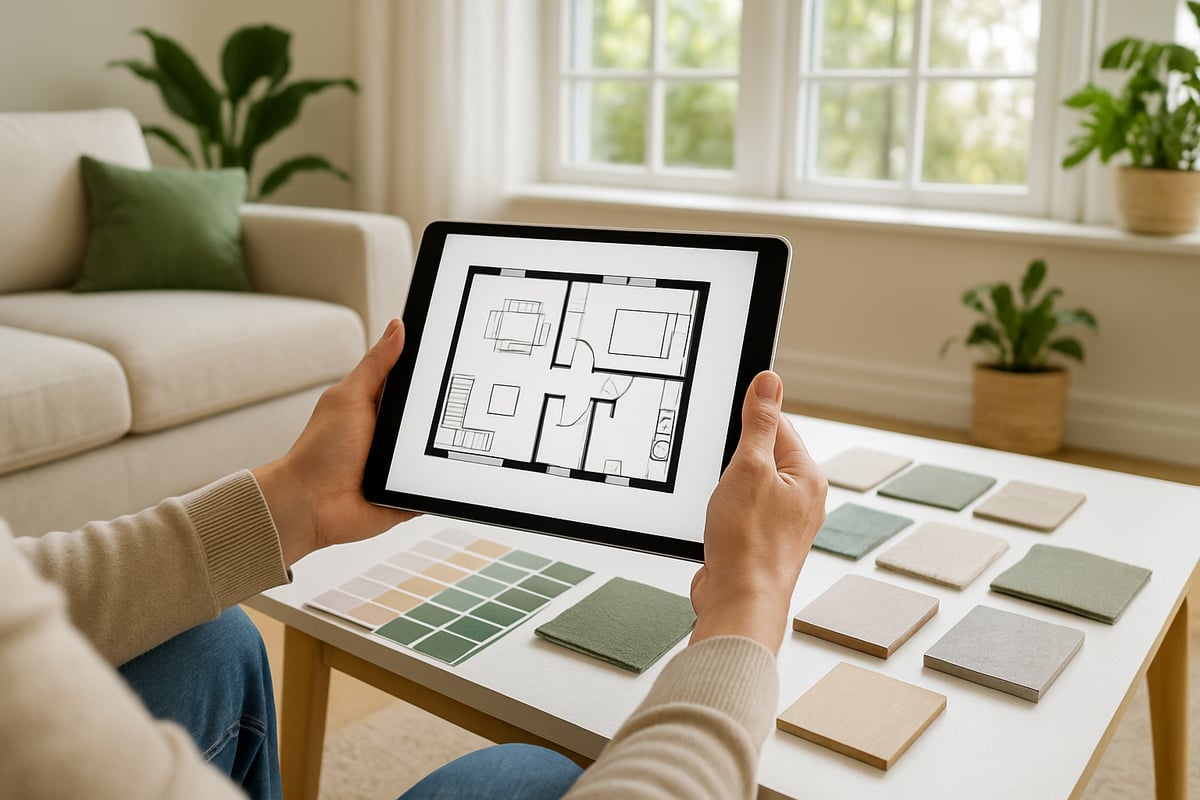
Att förstå ditt nuvarande utrymme
Börja med att utvärdera dimensionerna och layouten för varje rum. Mät bredd, längd och takhöjd, och notera placeringen av fönster och dörrar. Var särskilt uppmärksam på arkitektoniska detaljer, som nischer eller balkar, eftersom dessa kan bli fokuspunkter eller utgöra designutmaningar.
Identifiera styrkor och begränsningar i ditt hem. Till exempel kan en liten stadsbostad dra nytta av multifunktionella möbler, medan ett rymligt förortshus erbjuder större flexibilitet för zonindelning. Analysera naturliga ljuskällor, eftersom välbelysta utrymmen ofta känns större och mer inbjudande, vilket är avgörande för effektiv husets inredning.
Skapa en checklista för att dokumentera observationer:
- Rumsmått
- Fönster- och dörrplaceringar
- Unika egenskaper (eldstäder, inbyggda möbler)
- Problemområden (besvärliga hörn, låga tak)
Detta steg ger dig en tydlig översikt över din interiörs potential.
Att definiera dina inredningsmål
Efter att ha förstått ditt utrymme, klargör vad du vill uppnå med dina husets inredningsinsatser. Prioriterar du komfort, estetik eller funktionalitet? Skapar du en familjevänlig miljö, ett utrymme för underhållning eller en produktiv arbetsplats hemma?
Sätt dina prioriteringar genom att lista måste-ha kontra trevligt-att-ha. Moodboards eller digitala designverktyg, som Pinterest och Canva, kan hjälpa till att visualisera din vision. Samla bilder, färgprover och materialprover för att vägleda dina beslut.
Fråga dig själv:
- Vilka aktiviteter sker i varje rum?
- Vem använder utrymmet mest?
- Vilken stämning vill du framkalla?
Att anpassa dina mål efter din livsstil säkerställer en meningsfull designresa.
Att fastställa en realistisk budget
En välplanerad budget är avgörande för varje husets inredningsprojekt. År 2025 varierar genomsnittskostnaderna från 50 till 200 dollar per kvadratfot, beroende på din plats och materialval. Dela upp din budget för att täcka möbler, ytskikt, arbetskraft och en reservfond för oväntade utgifter.
Exempel på budgetfördelningstabell
| Kategori | Procentandel av total budget |
|---|---|
| Möbler | 40% |
| Ytbehandlingar | 25% |
| Arbetskraft | 25% |
| Reservplan | 10% |
Sök kostnadsbesparande strategier, som att återanvända befintliga delar eller handla under reor. Kom ihåg att kvalitetsinvesteringar i nyckelområden, som sittplatser eller golv, kan löna sig i hållbarhet och komfort för ditt hus inom inredning.
Tidslinjeplanering
Planera din projekttidslinje baserat på omfattningen av ditt hus inom inredning. Enkla rumsuppfräschningar kan ta några veckor, medan omfattande renoveringar, som kök, ofta kräver 8 till 12 veckor. Bygg alltid in bufferttid för potentiella förseningar, som restorder på material eller oväntade reparationer.
Typiska projekttidslinjer:
- Vardagsrumsuppfräschning: 2-4 veckor
- Köksrenovering: 8-12 veckor
- Badrumsuppdatering: 4-6 veckor
Använd digitala verktyg eller en väggkalender för att följa milstolpar. Detta håller ditt projekt organiserat och minskar stress, vilket säkerställer att du håller tidsplanen.
Samla inspiration och resurser
Håll dig inspirerad genom att utforska plattformar som Pinterest, Houzz och ledande designmagasin. Analysera trendande stilar, som biophilic design och Japandi, för att se vad som passar din smak. Att skapa ett digitalt scrapbook låter dig kurera idéer och visualisera ditt framtida hem.
För insikt i de senaste trenderna som formar hus inom inredning 2025, konsultera resurser som 2025 Casa Decor trend guide. Detta kan hjälpa dig att identifiera färger, material och koncept som stämmer överens med dina mål.
Med en tydlig vision, en praktisk budget och gott om inspiration är du redo att ge dig ut på din designresa med självförtroende.
Steg 2: Bemästra inredningsprinciper
Att skapa ett vackert hus inom inredning handlar om mer än att bara välja fina saker. Att bemästra grundläggande principer säkerställer att varje utrymme känns genomtänkt, balanserat och perfekt anpassat efter dina behov. Låt oss utforska kärnkoncepten som lyfter varje interiör från vanlig till extraordinär.
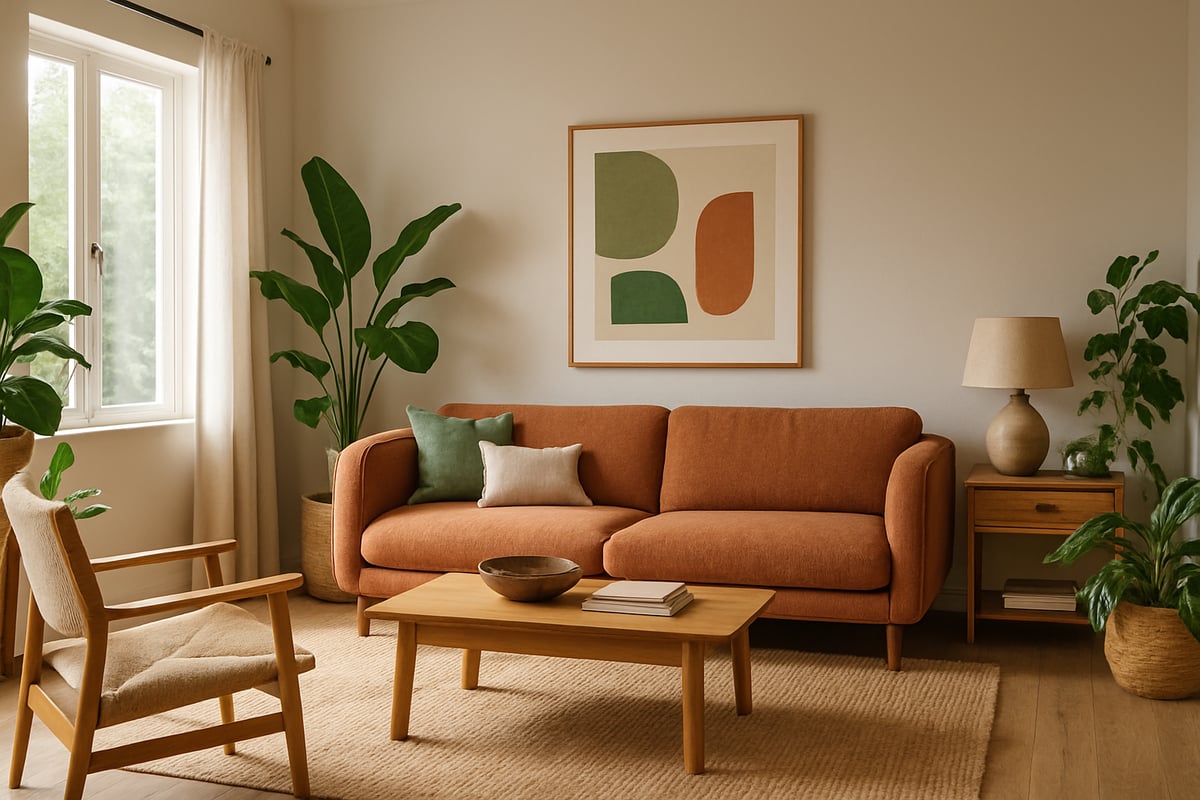
Färgteori och palettval
Färg är hjärtat i varje hus inom inredningsprojekt. Färgerna du väljer kan ge energi, lugna eller inspirera. Till exempel främjar blått och grönt avslappning i sovrum, medan varma gula och orange skapar ett livligt kök.
År 2025 inkluderar trendande paletter jordnära toner som oliv, lera och sand, samt djärva kontraster och dämpade pasteller. Den psykologiska effekten av dessa val kan förändra ditt humör och hur du interagerar med varje rum. För inspiration och expertinsikter om de senaste färgtrenderna, kolla in Interior Design Trends 2025.
När du väljer din färgpalett, börja med en basfärg, lägg till kompletterande nyanser och avsluta med accentfärger. Provmåla färgprover i ditt utrymme innan du bestämmer dig.
Rumsplanering och flöde
Effektiv rumsplanering är avgörande för en funktionell inredning i huset. Börja med att kartlägga trafikmönster för att säkerställa att rörelsen känns naturlig och obehindrad. Tänk på hur rummet ska användas—öppna planlösningar är populära för sociala ytor, medan slutna planlösningar ger privatliv för sovrum och kontor.
Möbelarrangemang påverkar både flöde och komfort. Använd digitala verktyg eller rutat papper för att experimentera med layouter innan du flyttar tunga möbler. Prioritera tydliga gångvägar och undvik att överbelasta rummet.
Öppna planlösningar är fortfarande efterfrågade, men kom ihåg att den bästa layouten är den som passar din livsstil och maximerar ditt hems unika egenskaper.
Grundläggande belysningsdesign
Belysning är ett kraftfullt verktyg inom husets inredning som påverkar både funktion och stämning. Det finns tre huvudtyper: allmänbelysning (ambient), arbetsbelysning (task) och accentbelysning (dekorativ). Att lägga lager av dessa skapar djup och flexibilitet.
Naturligt ljus höjer humöret och får utrymmen att kännas större. Använd tunna gardiner för att förstärka dagsljuset och lägg till speglar för att reflektera ljuset djupare in i rummet. På kvällen, kombinera takarmaturer, bordslampor och belysning under skåp för en balanserad effekt.
Statistik visar att välbelysta hem kan öka det upplevda värdet med upp till 20 procent. Genomtänkt belysningsdesign förbättrar varje annan inredningsdetalj.
Textur, mönster och lager
Textur och mönster ger personlighet och värme till huset inom inredning. Att blanda material som trä, metall, sten och textilier tillför dimension och intresse. Till exempel, kombinera en sammetssoffa med en jute-matta och metallbord för en sofistikerad, lager-på-lager-look.
Mönster kan vara djärva eller subtila, men balans är nyckeln. För många livliga tryck kan bli överväldigande, medan några välplacerade mönster skapar visuell spänning. Prova att lägga lager av mattor, lägga till texturerade väggpaneler eller använda mönstrade kuddar.
Att lägga lager av olika element skapar mysighet och djup, vilket gör att varje rum känns inbjudande och levande.
Fokuspunkter och visuell balans
Varje rum i huset inom inredning gynnas av en fokuspunkt—en detalj som drar blicken och förankrar rummet. Det kan vara en öppen spis, stor konst eller en soffa i djärv färg.
Balans uppnås genom att arrangera möbler och dekorationer runt denna fokuspunkt. Symmetri ger en känsla av ordning, medan asymmetri tillför energi och rörelse. Till exempel, använd matchande lampor på vardera sidan av en säng för symmetri, eller blanda ramar i olika storlekar för en eklektisk gallervägg.
En välvald fokuspunkt ger ditt rum en tydlig identitet och gör inredningsbeslut enklare.
Proportion och skala
Att välja rätt möbelstorlek är avgörande för harmonisk husinredning. Överdimensionerade möbler i ett litet rum känns trångt, medan små möbler i ett stort utrymme ser borttappade ut.
Använd visuella trick för att förstora utrymmet. Höga speglar drar blicken uppåt och får tak att kännas högre. Välj smala möbler med upphöjda ben för att öppna upp trånga områden. Mät alltid innan köp och använd målartejp för att markera potentiella möbler på golvet.
Proportion säkerställer att varje element känns genomtänkt och att dina rum är både vackra och bekväma.
Hållbarhet och miljövänliga val
Hållbarhet är en toppprioritet i 2025 års husinredning. Fler husägare söker återvunna material, energieffektiv belysning och miljöcertifierade produkter. Leta efter certifieringar som FSC för trä och GREENGUARD för lågemissionsytor.
Miljövänlig design är inte bara bättre för planeten utan också hälsosammare för din familj. Välj hållbara material som åldras vackert och prioritera saker som kan repareras eller återanvändas. Data visar att 68 procent av husägare nu föredrar hållbara alternativ.
Medvetna val säkerställer att ditt hem är stilfullt, ansvarsfullt och framtidssäkert.
Steg 3: Designa varje rum med syfte
Varje hem förtjänar ett genomtänkt tillvägagångssätt för husets inredning. Varje rum har en unik funktion, och att anpassa din strategi till dessa utrymmen säkerställer komfort, skönhet och praktisk användning. Låt oss bryta ner hur man designar varje område med avsikt, stil och bestående intryck.
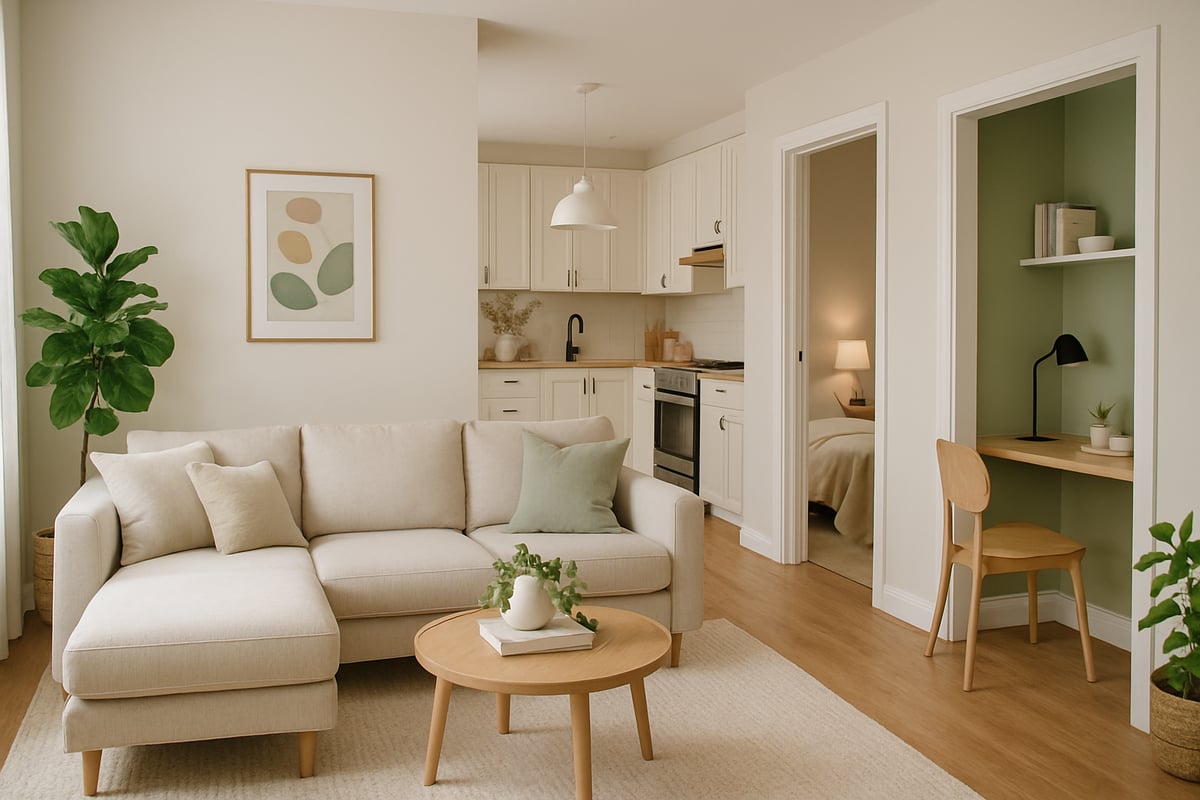
Vardagsrum: Komfort möter stil
Vardagsrummet är ofta navet i husets inredning och balanserar avkoppling och social interaktion. Börja med att definiera zoner för samtal, media och vila. Multifunktionella möbler, som modulsoffor och nästlade bord, anpassar sig efter förändrade behov.
För planlösningen, tänk på trafikflöde och naturliga fokuspunkter som en öppen spis eller stort fönster. Att lägga lager av olika texturer—tänk en mjuk matta, sammetskuddar och en läderpuff—ger djup. Om du behöver hjälp att välja den perfekta sittplatsen, konsultera en online-sofadesignguide 2025 för att matcha ditt utrymme och din stil.
Förvaring är också viktigt. Inbyggda hyllor eller dolda förvaringspuffar håller röran borta. Glöm inte belysningen: kombinera takarmaturer, golvlampor och accentbelysning för mångsidighet.
Köket: Hemmets hjärta
I husets inredning är köket centrum för aktivitet. Börja med att optimera arbetsflödet, använd kökstriangeln—diskho, spis och kyl ska bilda en effektiv väg.
Smarta apparater är trendiga 2025 och erbjuder bekvämlighet och energibesparingar. För material är matta skåp och kvartsbänkskivor både stilfulla och hållbara. Öppna hyllor kan visa vackra tallrikar, medan djupa lådor maximerar förvaringen.
Belysning är avgörande. Använd LED-lampor under skåp för arbetsuppgifter och pendellampor för stämning. Välj ytbehandlingar som matchar intilliggande utrymmen för ett sammanhängande utseende. Lägg till grönska eller en djärv stänkskydd för personlighet.
Sovrum: Skapa en vilsam tillflyktsort
Ett väl designat sovrum i husets inredning främjar avkoppling och vilsam sömn. Börja med det väsentliga: en högkvalitativ madrass och mörkläggningsgardiner för optimal komfort.
Välj lugnande färgscheman, som mjuka blå toner eller varma neutrala färger, för att främja lugn. Personifiera utrymmet med konstverk, texturerade plädar och lager på lager med sängkläder. Sängbord med inbyggda laddstationer ger modern bekvämlighet.
Håll röran minimal med förvaring under sängen eller inbyggda garderober. Lägg till en läshörna med en mysig stol och lampa för privata stunder. Mjuk, dimbar belysning skapar den perfekta stämningen för avkoppling.
Badrum: Spa-liknande lugn
Badrum gynnas av genomtänkt husets inredning, särskilt när utrymmet är begränsat. Välj platsbesparande armaturer som väggmonterade handfat och flytande kommoder för att skapa en öppen känsla.
Trender för 2025 inkluderar walk-in-duschar med ramlöst glas och golvvärme för extra komfort. Använd ljusa, neutrala färger för att visuellt förstora rummet. Integrerad belysning i speglar och under skåp förbättrar funktionaliteten.
Lägg till textur med naturstensplattor eller trädetaljer. Håll förvaringen praktisk—flytande hyllor eller infällda nischer håller toalettartiklar prydligt. Överväg beröringsfria kranar för hygien och effektivitet.
Hemmab kontor: Produktivitet och komfort
En dedikerad arbetsplats är avgörande i modern husets inredning. Ergonomiska möbler stödjer hållning och långa arbetstimmar, medan ljudisolering förbättrar fokus.
Organisera kablar med brickor eller grommets för ett prydligt utseende. Placera ditt skrivbord nära ett fönster för naturligt ljus och använd justerbara lampor för arbetsbelysning. Inbyggda hyllor eller modulära enheter håller förnödenheter inom räckhåll.
Personliga inslag, som inspirerande konst eller grönska, skapar en motiverande atmosfär. Kom ihåg att 74 % av distansarbetare värdesätter ett dedikerat kontor, vilket gör denna investering värdefull för produktivitet och välmående.
Entré och korridorer: Första intrycket
Entréer och korridorer sätter tonen i husets inredning och kombinerar funktion med stil. Använd inbyggda bänkar, krokar och skoskåp för att samla dagliga nödvändigheter.
Spegelar reflekterar ljus och får smala utrymmen att kännas större. Välj hållbara golv, som kakel eller lyxig vinyl, för att tåla mycket fottrafik. Accentbelysning leder gäster och framhäver arkitektoniska detaljer.
Lägg till personlighet med en djärv matta eller ett statementkonstverk. Överväg ett litet konsolbord för post och nycklar. Håll gångvägar fria för att säkerställa enkel rörelse i hela hemmet.
Barnrum och flexibla ytor
Barnrum och flexibla ytor visar på husets inrednings anpassningsbarhet. Välj möbler som utvecklas—omvandlingsbara spjälsängar, modulära hyllor eller skrivbord som växer med ditt barn.
Prioritera säkerhet med rundade hörn, säkra fästen och tvättbara material. Använd glada färger och temadekor för skoj, men håll baspaletten neutral för långvarighet.
Flexibla utrymmen kan fungera som lekrum, gästrum eller hobbyområden. Inkludera förvaringslådor, utdragbara sängar eller flyttbara avskiljare för att enkelt kunna omkonfigurera utrymmet när behoven förändras.
Steg 4: Val av material, möbler och dekoration
Att välja rätt material, möbler och dekoration kan förvandla house inside interiördesign från ordinärt till exceptionellt. Detta steg handlar om att göra genomtänkta val som speglar din stil, stödjer vardagslivet och håller ditt hem i takt med 2025 års viktigaste trender.
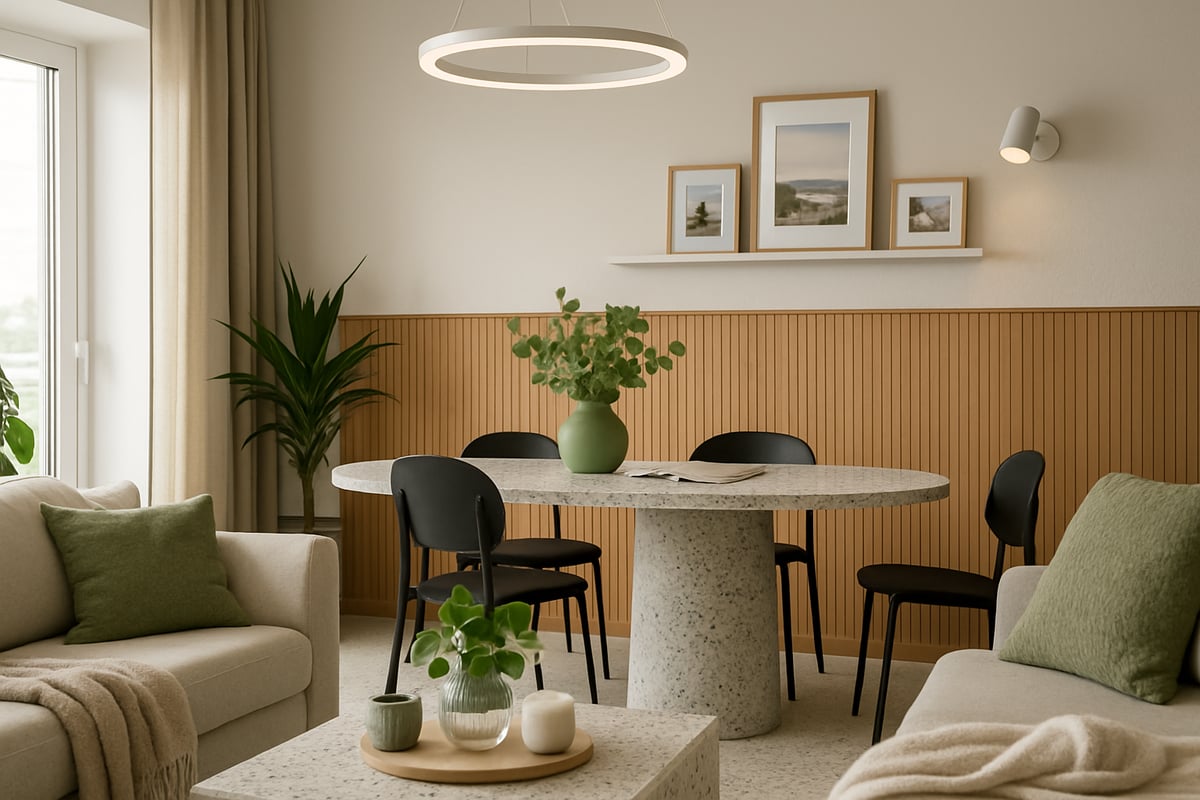
Att välja kvalitetsmaterial
Kvalitetsmaterial är grundläggande för hållbar house inside interiördesign. Att hitta en balans mellan hållbarhet och estetik säkerställer att dina interiörer förblir vackra och funktionella över tid. År 2025 inkluderar populära val terrazzo för bänkskivor, bambu för golv och återvunnet glas för accentdetaljer.
När du utvärderar material, leta efter certifieringar som FSC för trä eller GREENGUARD för lågemissionsprodukter. Dessa märken visar ett engagemang för hälsa och hållbarhet. För en djupdykning i vad som är trendigt, lyfter Interior Design Trends 2025-guiden fram innovativa material och paletter som formar årets interiörer.
Hållbara material minskar inte bara din miljöpåverkan utan bidrar också till en hälsosammare hemmiljö. Tänk alltid på hur varje material kommer att fungera i områden med mycket trafik eller fukt.
Möbelval och arrangemang
Möbler är ryggraden i house inside interiördesign och sätter både funktion och stil. Att kombinera investeringsobjekt, som ett matbord i massivt trä, med prisvärda fynd låter dig balansera kvalitet och budget. Specialtillverkade möbler erbjuder skräddarsydda lösningar för svåra utrymmen, medan färdiga alternativ ger bekvämlighet och snabba uppdateringar.
Tänk på ergonomi, särskilt för saker som stolar och soffor. Statement-möbler, som ett djärvt matbord eller en designad loungestol, kan fungera som fokuspunkter och göra dina interiörer minnesvärda.
Arrangera möbler för att förbättra flödet och maximera utrymmet. Modulsoffor och utdragbara bord är utmärkta för flexibla layouter, särskilt i hem med föränderliga behov.
Accessoarer med syfte
Accessoarer ger liv åt house inside interiördesign. Mattor, gardiner och kuddar tillför värme, färg och textur, vilket hjälper till att förena din övergripande stil. Använd "regeln om tre" när du stylar hyllor eller soffbord för att skapa visuellt intresse utan rörighet.
Konstplacering är en annan viktig detalj. Häng konstverk i ögonhöjd och gruppera bitar genomtänkt för effekt. Välj accessoarer som speglar din personlighet och kompletterar din valda färgpalett.
Att lägga lager av olika texturer, som sammetskuddar med vävda plädar, skapar djup och komfort. Rotera accessoarer säsongsmässigt för att hålla ditt utrymme fräscht.
Integrera teknologi
Modern husets inredning inkluderar ofta smart teknik för bekvämlighet och effektivitet. Integrera enheter som smarta termostater, automatiserad belysning eller röststyrda assistenter för att förenkla vardagsrutiner.
Välj dolda tekniska lösningar, som inbyggda högtalare eller integrerade laddstationer, för att behålla ett rent och prydligt utseende. Smarta belysningssystem kan programmeras för olika stämningar och tider på dygnet, vilket förbättrar både atmosfär och energibesparing.
Tänk på hur teknologin kan smälta in sömlöst i din inredning. Välj ytbehandlingar och designer som kompletterar din övergripande estetik, så att tekniken förbättrar snarare än stör ditt utrymme.
Personifiera ditt utrymme
Personliga inslag är det som gör husets inredning verkligen din. Visa upp samlingar, reseminnen eller familjefoton för att tillföra karaktär och berätta din historia. Gör-det-själv-dekorprojekt, som handmålade vaser eller specialanpassad väggkonst, fyller ditt utrymme med kreativitet.
Byt ut dekorationsföremål med årstiderna eller när dina smak förändras. Detta håller dina interiörer dynamiska och engagerande. Personalisering går bortom estetik och stödjer komfort och välbefinnande för alla i ditt hem.
Genom att noggrant välja material, möbler och dekorationer säkerställer du att husets inredning förblir både tidlös och anpassad efter din livsstil.
Steg 5: Genomföra din designplan
Att genomföra din vision för husets inredning är där dina planer blir verklighet. Denna avgörande fas kräver noggrann samordning, uppmärksamhet på detaljer och förmåga att anpassa sig när projektet fortskrider. Genom att hålla dig organiserad och fokuserad kan du säkerställa att dina ansträngningar leder till ett fantastiskt och funktionellt hem.
Skapa en detaljerad handlingsplan
Börja med att dela upp ditt husets inredningsprojekt i tydliga, hanterbara faser. Dela upp stora uppgifter i mindre steg, som målning, golvläggning och möbelmontering. Använd projektledningsappar eller digitala checklistor för att hålla allt på rätt spår. Gantt-scheman är särskilt hjälpsamma för att visualisera din tidslinje och beroenden, vilket säkerställer att inget steg förbises.
Organisera din plan efter rum eller funktion. Till exempel, schemalägg köksrenoveringar innan du dekorerar vardagsrummet. Lägg till bufferttid för oväntade förseningar. Granska regelbundet din plan och justera vid behov för att behålla tempot.
Anlita proffs vs. Gör det själv
Att bestämma sig för att anlita proffs eller göra jobbet själv är en viktig aspekt av husets inredning. För komplexa projekt, som elarbete eller specialanpassade skåp, leder professionell hjälp ofta till bättre resultat och färre misstag. Rådgör med designers eller entreprenörer när du saknar kunskaper eller tid.
En kostnads-nyttoanalys kan hjälpa dig avgöra vilka uppgifter du bör lägga ut. Enligt Interior Design Trends 2025 ångrar många husägare att de inte sökte expert hjälp för komplicerade renoveringar. Väg dina alternativ noggrant för att maximera värde och minimera stress.
Beställning och schemaläggning av leveranser
Korrekt schemaläggning är avgörande i husinredning. Koordinera leveransdatum för möbler, armaturer och material så att de stämmer överens med din projektplan. Bekräfta ledtider med leverantörer och förutse eventuella restorder eller förseningar i frakten.
Skapa ett huvudleveransschema och kommunicera regelbundet med leverantörer. Om varor anländer i fel ordning, justera din plan för att undvika arbetsstopp. Förvara material på en ren, torr plats för att undvika skador före installation. Dessa steg hjälper till att hålla ditt projekt igång smidigt.
Övervakning av installation och kvalitetskontroll
Övervaka installationsfasen noggrant för att säkerställa att varje detalj stämmer överens med din husinredningsplan. Gå igenom varje område med entreprenörer och hänvisa till din ursprungliga checklista och ritningar. Ta itu med frågor eller problem snabbt för att undvika kostsamma misstag.
Använd en kvalitetskontrollista för slutinspektioner. Kontrollera att färgfinish är jämn, fogar sömlösa och armaturer korrekt placerade. Om du upptäcker problem, begär omedelbara korrigeringar innan du godkänner arbetet. Denna noggrannhet säkerställer att din vision förverkligas som avsett.
Slutlig styling och justeringar
Nu är det dags för de sista detaljerna i din husinredningsresa. Arrangera dekorationer, konstverk och textilier för att skapa ett enhetligt utseende. Bjud in feedback från vänner eller familj för att få ett nytt perspektiv på rummet.
För mer inspiration om mysiga, personliga interiörer, utforska denna guide till modern cottage-inredningsstil. Gör små justeringar vid behov och fira sedan ditt förvandlade hem med en sammankomst eller en stilla stund av uppskattning.
Steg 6: Hålla din inredning fräsch och funktionell
Att bevara skönheten och funktionaliteten i din husinredning är en pågående process. Med genomtänkta uppdateringar och regelbunden skötsel kan ditt hem förbli både stilfullt och praktiskt i många år framöver.
Säsongsuppdateringar och underhåll
Att fräscha upp ditt hus inomhus med inredning efter årstiderna får ditt utrymme att kännas nytt och inbjudande. Byt ut textilier som kuddar, plädar och mattor för att spegla årstiden. Förvara säsongsaccessoarer i märkta lådor för enkel rotation.
Rutinvård är också viktigt. Dammsug och rengör stoppade möbler grundligt var sjätte månad för att bevara tygkvaliteten. Dammtorka hyllor, lampor och golvlister regelbundet. Använd lämpliga rengöringsmedel för hårda ytor för att undvika skador. Dessa insatser säkerställer att din design håller och alltid ser bäst ut.
Anpassa sig till förändrade behov
När din hushållssituation förändras bör även din inredning göra det. Växande familjer, nya hobbyer eller behovet av ett hemmakontor kan kräva justeringar. Modulära möbler gör det enkelt att anpassa layouten när behoven skiftar.
Överväg flexibla lösningar som omvandlingsbara soffor eller justerbara hyllor. Omorganisera utrymmen för att rymma distansarbete eller barnens lekområden. Genom att planera för förändring förblir dina interiörer funktionella och stödjer din livsstil.
Hålla sig uppdaterad med trender
Att hålla din inredning aktuell kräver inte en fullständig makeover. Istället kan du införa små, reversibla uppdateringar som nya kuddar eller väggkonst. Denna metod låter dig experimentera med trender utan större åtaganden.
För inspiration, följ designbloggar, sociala mediekonton och årsrapporter. Utforska de senaste Inredningstrender 2025 för att upptäcka nya idéer inom färg, material och dekoration. På så sätt känns ditt hem både modernt och unikt ditt.
Hållbart underhåll
Miljövänligt underhåll blir allt viktigare inom inredning. Välj gröna rengöringsprodukter för daglig vård för att minska exponeringen för starka kemikalier. Reparera eller återanvänd möbler för att minimera avfall och förlänga livslängden på dina möbler.
När du vill göra dig av med saker, överväg gemenskapsbyten eller att donera till lokala välgörenhetsorganisationer. Dessa metoder stödjer hållbarhet samtidigt som ditt hem hålls organiserat och fritt från oreda.
Mäta tillfredsställelse och njutning
Utvärdera hur ditt hems interiöra design stödjer ditt dagliga liv. Känns ditt utrymme bekvämt, effektivt och välkomnande? Be familjemedlemmar om feedback för att säkerställa att allas behov tillgodoses.
Håll en löpande lista över förbättringar eller framtida förändringar du vill göra. Regelbunden reflektion hjälper dig att behålla ett hem som verkligen förbättrar ditt välbefinnande och din lycka.
Som du har sett är det verkligen möjligt att förvandla ditt hems interiör med rätt steg-för-steg-metod – från att sätta tydliga mål till att bemästra designprinciper och genomföra din vision med självförtroende. Om du är redo att förvandla inspiration till verkliga resultat och vill ha expertvägledning varje steg på vägen, varför inte ta dina färdigheter till nästa nivå med en praktisk kurs? Du får praktiska tekniker som ger dig möjlighet att fatta välgrundade beslut och skapa ett utrymme du kommer att älska.
Börja din resa idag och Kom igång med inredning.





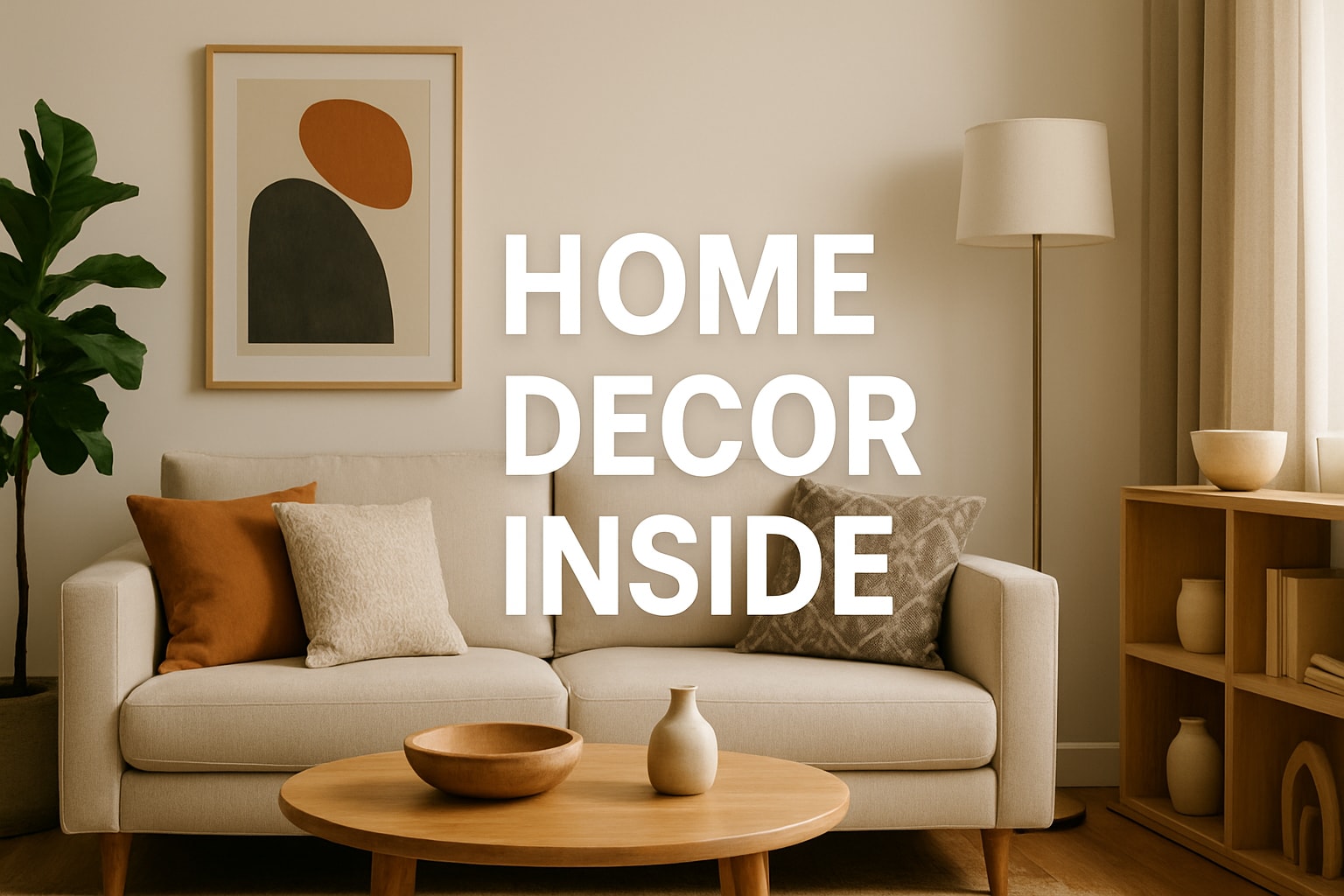
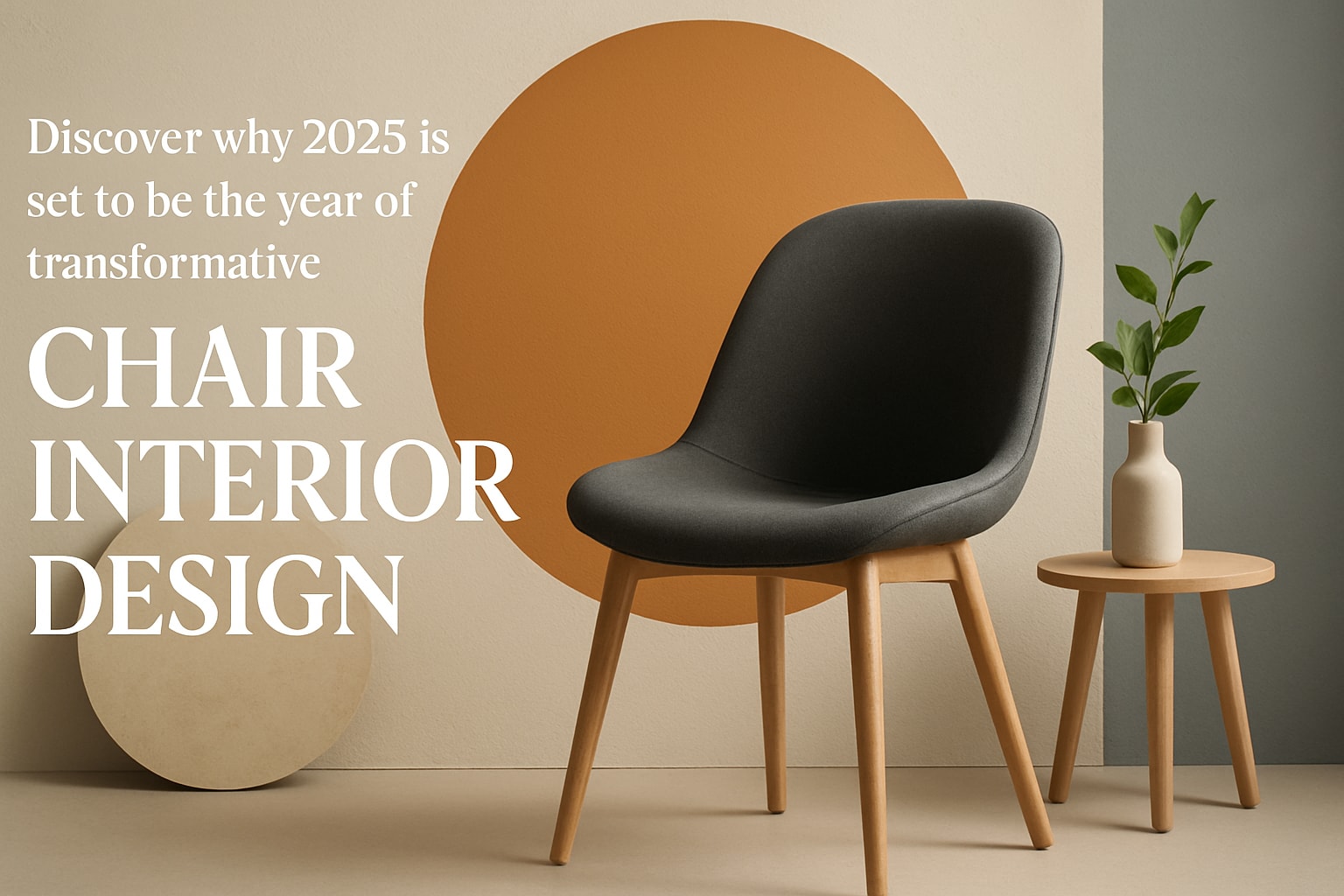
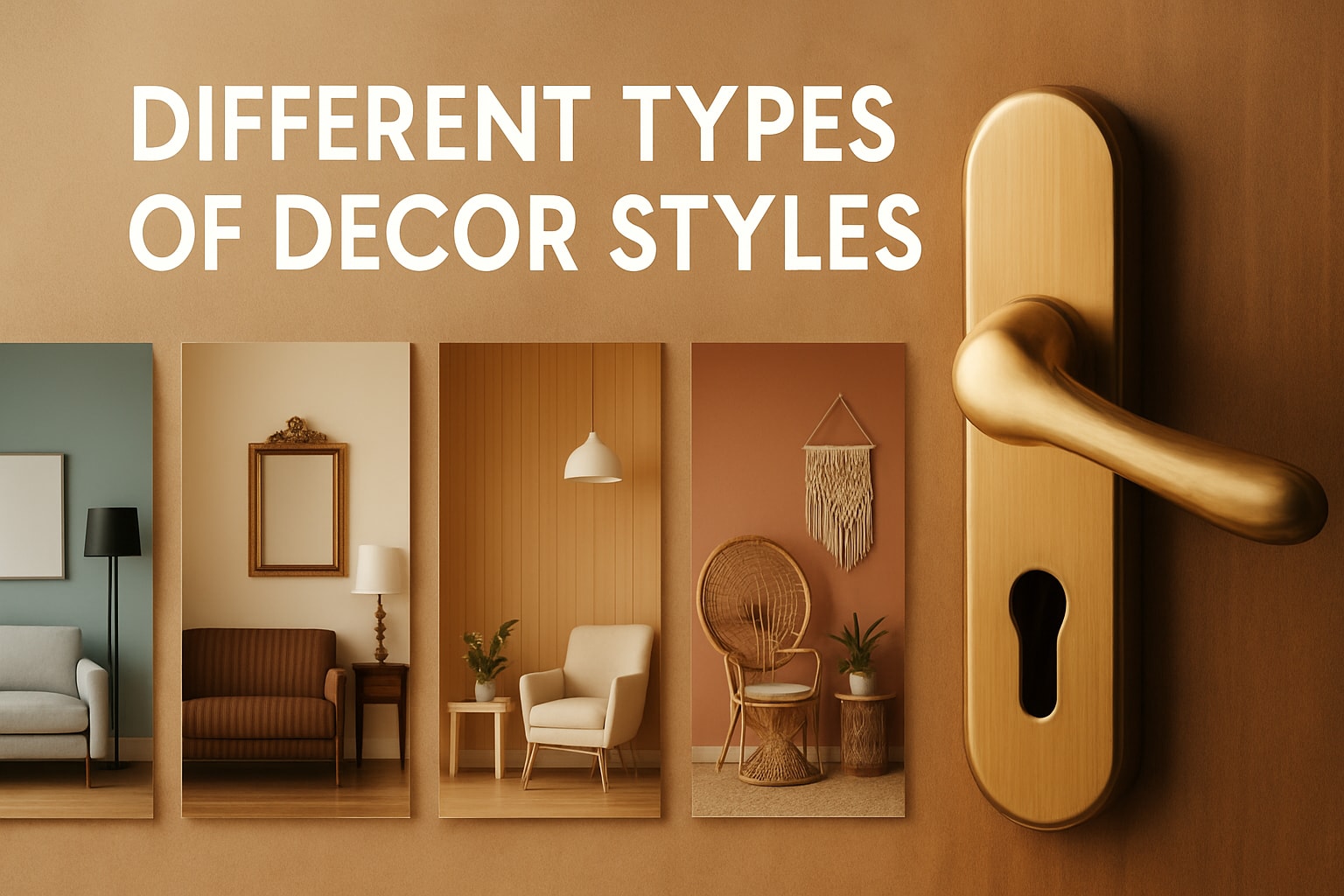
Dela:
Jordnära modern inredningsguide för inspirerade utrymmen 2025
2025 heminredningstrender - Guide för husdesign och dekoration: